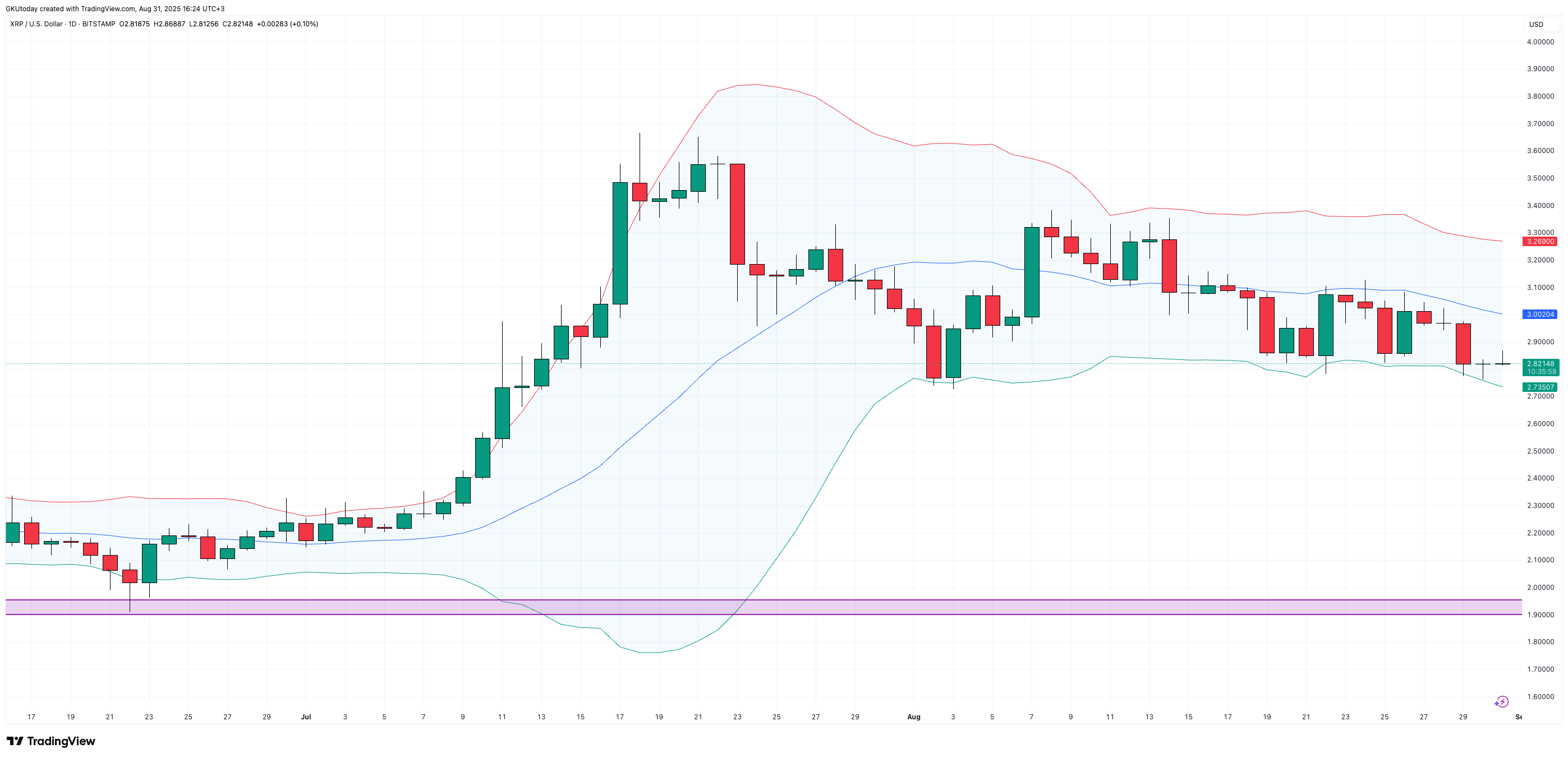XRP Bollinger Bands show a narrowing range with the midline tilting down, indicating weakening momentum. Price trading below the midline and repeated rejections near $3.10–$3.20 point to defensive sentiment; a break below $2.70 risks a slide toward $2.40 while reclaiming $3.00 would signal strength.
-
XRP remains biased lower as Bollinger Bands compress and the midline slopes downward.
-
Price repeatedly rejected at $3.10–$3.20; lower band support sits near $2.70, next interest area around $2.40.
-
Reclaiming $3.00 would be the clearest bullish signal; current structure favors caution into September.
XRP Bollinger Bands show weakening momentum below $3.00, with key levels at $2.70 and $2.40. Read COINOTAG’s concise analysis and actionable next steps to monitor price.
What do XRP Bollinger Bands indicate?
XRP Bollinger Bands indicate momentum is weakening as the weekly midline slopes downward and price remains below that midline. Shorter timeframes show repeated rejections near $3.10–$3.20, leaving the token closer to the lower band, which favors further downside pressure unless $3.00 is reclaimed.
How likely is XRP to rally based on Bollinger Bands?
On weekly and daily charts, XRP has slipped from early-summer highs near $3.60 and is now holding just above $2.80. For most of August, the daily price stayed below the midline, and each push toward $3.10–$3.20 was rejected. That pattern signals a lack of buyer conviction at higher levels.
Short-term charts (12-hour, 4-hour, 1-hour) confirm the same bias. Price action has been grinding along the lower band rather than expanding above the midline. If the lower band near $2.70 breaks, the next meaningful support zone is around $2.40. Conversely, reclaiming the $3.00 zone would be an early sign that momentum is shifting.

Source: TradingView
Why is the midline slope important for XRP?
The middle Bollinger Band (typically a 20-period moving average) helps define trend direction. A downward-sloping midline signals that recent averages are falling, which often coincides with sellers controlling price. For XRP, the midline slope has moved from flat to down, reinforcing a cautious near-term outlook.
How should traders interpret the current Bollinger profile?
Use this checklist to interpret Bollinger Bands on XRP:
- Midline position: Price below midline = bearish bias.
- Band width: Narrowing bands = lower volatility; a breakout could be directional but must be confirmed.
- Band touches: Repeated lower-band tests suggest sellers are dominant; watch for a clean break.
- Confirmation levels: Reclaiming $3.00 confirms strength; breaking $2.70 targets $2.40.
Frequently Asked Questions
Is XRP about to rally?
Not imminently. Bollinger Bands show a biased low-volatility slide with price stuck below the midline. Only a clear close above $3.00, confirmed by volume, would increase the likelihood of a rally.
What are the immediate support and resistance levels?
Immediate resistance lies in the $3.00–$3.20 zone. Support is near the lower band at $2.70; a sustained breach could expose $2.40 as the next support area.
How should I trade XRP given the current setup?
Prefer risk-managed approaches: wait for a confirmed reclaim of $3.00 for bullish trades or a decisive break below $2.70 for protective short or defensive positioning. Use stop-losses and confirm with volume or momentum indicators.
Key Takeaways
- Bollinger Bands indicate weakness: Midline sloping down and price below it suggest defensive market posture.
- Key levels to watch: Resistance $3.00–$3.20; support $2.70 then $2.40.
- Trade plan: Wait for confirmation—reclaim $3.00 for bullish bias or break $2.70 for deeper downside risk.
Conclusion
Preserving the facts: XRP’s Bollinger profile through late August points to weakening momentum and a defensive market stance. Traders should watch the midline, band width, and the $3.00 / $2.70 / $2.40 levels for confirmation. COINOTAG will monitor updates and provide further analysis as the picture evolves.
